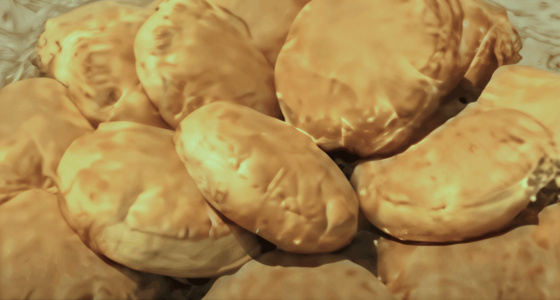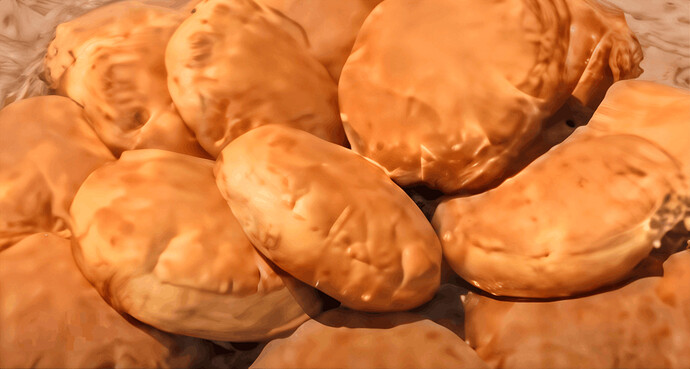There is no program in the world that does Color Correction, not even Adobe Lightroom. Unfortunately, improving the color of images is often called Color Correction, and this is not true. If you want proof, I challenge you to color correct these pictures. Yes, you will not be able to, no matter how hard you try, and I hope you keep them as a sample. This matter requires study. We look forward to seeing your software that corrects the colors of images in the future.
The objects in the photo look like some sort of buns. Please say exactly what they are. It’s mighty hard to correct color if you don’t know what the correct color is!
Of course it’s impossible to correct the colours in that picture: we have no reference whatsoever for what the colours should be.
What would be the reference point against which you declare an improvement…color accuracy or more pleasing to the eye… its a bit subjective to state it that way, ie use the word improve …so do you mean to say correct the color accuracy or representation of the original scene??
I spent 16 years in a company printing and publishing pictures, from post cards to fine-art prints. Colour correction is, as stated above, correcting the proof, print, reproduction of some kind, with reference to the original, or to a reference copy of it. Our reference (and reproduction source) of some art in a far-off gallery would be a 10 by 8 transparency*. Of course, it goes without saying that it would be done in controlled light.
One got fed up with comments from folk (colleagues sometimes), who had not even seen the original, that some colour was subtly wrong.
No original? No colour correction.
Even with photographs we take ourselves, we cannot know for sure the colour temperature of that place and day.
We can recognise/suspect certain colour castes, and we can use certain clues such as things which we know to be close to white. But we are not correcting (except in the sense of obvious faults) nor are we trying to produce a facsimile representation. We are trying to produce pleasing and realistic (or not) images.
As a photographer of people (concert musicians) in a country where complexions range from white to black, I would love to get their skin colour “right” for them. But I do not get to have them sit in on my editing sessions: i do not the “the original” as a reference for correction. Nor, of course, can I set up the lighting they played under. So I have to manage with approximate, according to my memory of them, realistic, and complimentary.
The arts world probably has its Mozarts, able to remember every shade and detail, but I’m told that generally, humans do not have accurate long memory of colour.
*History: a generation or two before my time there, colour separation (CMYK) would be done with a camera in the gallery, and an artist would paint a reference copy! Hard to believe, but I saw a stack of the paintings and was surprised at the explanation!
This picture has been butchered (clue: banding all over the place)… Where is the original? Why do you tag Darktable when the last software to have “changed” it is Gimp?
Frankly I don’t even understand what you are talking about. Are you some kind of troll or maybe just come here to spend some time instead of doing serious things???
Either that or just not very bright. Here’s his only other post to date:
OMG, not even Lightroom can do this, what hope is there for the developers of darktable? ![]()
The thing is, possible language barriers aside, what do you mean by ‘color correction’? This does not, as far as I am aware, have any one specific meaning…
Yeah, there is something strange in his grandiloquent tone and hard statements. Actually, I have no bloody idea why on Earth is this post written for ![]()
oranges are orange ![]()
If the original bun color is not CIELAB a* = 34.9721 +/- 1 and b* = 54.09 +/- 1 under D55 lighting, then it is not “correct” enough:
Some light reading for the OP … Color difference - Wikipedia
This is the absolute correct color ![]() .
.

it is bread!
Correcting the color of an image does not necessarily mean making it the original color, but rather making it closer to being clearer.
— Color enhancement is a non-destructive correction. Here, color correction was called color enhancement, and linguistic confusion occurred
There is actually no color correction yet, and there are no options that offer these features
I was expect that there is one of you who will understand what is meant. Perhaps if I had not commented, the matter would have reached the point where I would be accused of being a member of Freemasonry، wow!
How would one define a “clear” colour?
Why is color enhancement non-destructive?
Otherwise, I think we have a semantic rather than a photographic problem here.
making a colour "clearer is (here) an undefined concept
Looks like it’s you trying to create that confusion.
Given the tone and contents of your posts so far, guess I’ll just mute you (as far as my seeing your posts is concerned)
Olympic Truce
